Efficient space utilization in steel structure warehouse buildings is crucial for maximizing productivity, reducing operational costs, and ensuring smooth workflow. Optimizing space involves strategic planning, innovative design, and the implementation of modern storage solutions. This article explores various strategies to make the most of your warehouse space.
Assess Your Space Needs
Inventory Analysis: Begin by analyzing your inventory to understand the types of goods you store, their dimensions, weight, and turnover rates. This assessment helps in designing a steel structure warehouse building layout that accommodates different products efficiently.
Future Growth: Consider potential future growth. Planning for expansion ensures that your warehouse can adapt to increased inventory and changes in product lines without significant disruptions.

Strategic Layout Design
Flow Optimization: Design the warehouse layout to facilitate smooth and efficient movement of goods. Create designated areas for receiving, storage, picking, packing, and shipping to streamline operations.
Aisle Width: Balance the aisle width between storage density and operational efficiency. Narrower aisles increase storage space but require specialized equipment for navigation, while wider aisles improve accessibility but reduce storage capacity.
Vertical Space Utilization: Maximize vertical space by installing tall racking systems and using equipment such as forklifts or order pickers designed for high reach. Ensuring your steel structure warehouse can support these systems is essential.
Implement Advanced Storage Solutions
Racking Systems: Choose the right racking system based on your inventory characteristics. Options include:
- Selective Racking: Provides easy access to all pallets, suitable for warehouses with a wide variety of products.
- Drive-In/Drive-Thru Racking: Ideal for high-density storage of homogenous products with a last-in, first-out (LIFO) or first-in, first-out (FIFO) system.
- Push Back Racking: Allows multiple pallets to be stored on inclined rails, suitable for LIFO systems.
- Cantilever Racking: Best for storing long, bulky items like pipes and lumber.
Mezzanine Floors: Adding mezzanine floors can effectively double the usable space in your warehouse. They can be used for additional storage, office space, or work areas without expanding the building’s footprint.
Automated Storage and Retrieval Systems (AS/RS): Implementing AS/RS can significantly increase storage density and improve retrieval times. These systems use computer-controlled equipment to automatically place and retrieve items from storage locations. The steel warehouse building can be single span or long span steel structure design to suit different requirements.

Optimize Workflow and Processes
Inventory Management System: Implement a robust inventory management system (IMS) to track inventory levels, locations, and movements. This system helps in maintaining optimal stock levels, reducing excess inventory, and improving order fulfillment accuracy.
Cross-Docking: Reduce storage needs by implementing cross-docking, where incoming goods are directly transferred to outbound shipping with minimal handling and storage time.
Zone Picking: Organize the warehouse into zones based on product categories or order characteristics. Zone picking reduces travel time for pickers, improving efficiency and accuracy.
Enhance Accessibility and Safety
Clear Signage and Labels: Use clear signage and labels to identify aisles, storage locations, and products. This practice reduces search time and improves the efficiency of picking and restocking operations.
Safety Measures: Ensure the warehouse is designed with safety in mind. Install guardrails, safety netting, and proper lighting to prevent accidents and facilitate safe movement within the warehouse.
Regular Maintenance: Regularly inspect and maintain racking systems, equipment, and the building structure to ensure everything is in good working condition. Proper maintenance prevents disruptions and extends the lifespan of your warehouse infrastructure.
Invest in Technology
Warehouse Management System (WMS): A WMS helps manage and optimize warehouse operations, including inventory tracking, order picking, and shipment processing. It provides real-time data, enhancing decision-making and operational efficiency.
Mobile Devices and Barcode Scanners: Equip staff with mobile devices and barcode scanners to streamline inventory management and reduce errors. These tools enable quick and accurate data entry and retrieval.
IoT and Sensors: Implement IoT devices and sensors to monitor warehouse conditions, such as temperature and humidity, ensuring optimal storage conditions for sensitive goods. They can also track equipment usage and maintenance needs.
Continuous Improvement and Training
Employee Training: Invest in regular training for warehouse staff to ensure they are proficient in using equipment, following safety protocols, and utilizing the WMS. Skilled employees contribute to a more efficient and safer warehouse environment.
Continuous Improvement: Encourage a culture of continuous improvement. Regularly review warehouse operations, solicit feedback from employees, and implement changes to improve efficiency and space utilization.
Sustainable Practices
Energy Efficiency: Incorporate energy-efficient lighting, such as LED fixtures, and optimize HVAC systems to reduce energy consumption. These measures can lower operational costs and create a more sustainable warehouse.
Waste Reduction: Implement recycling programs and practices to reduce waste. Properly disposing of packaging materials and encouraging the reuse of pallets and containers contribute to a more efficient and environmentally friendly operation.
Optimizing space in steel structure warehouse buildings involves a multifaceted approach that includes strategic layout design, advanced storage solutions, efficient workflows, and the integration of technology. By carefully planning and continuously improving your warehouse operations, you can maximize space utilization, enhance productivity, and ensure a safe and efficient working environment. Investing in proper training and sustainable practices further supports long-term efficiency and cost savings. To know different solutions of steel structures, you can open this website for your reference: https://aicranemachine.com/steel-structure/.